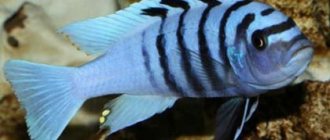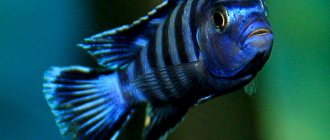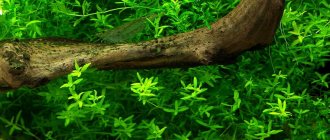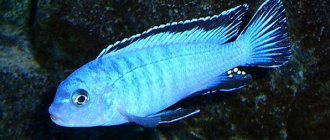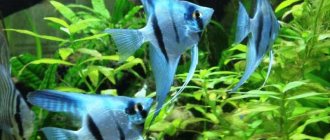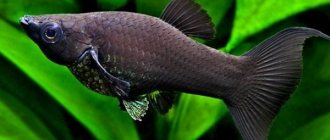4.6
(5)
Malawian cichlids occupy a special place in the world of aquariums. They have a very bright appearance, they are interesting to keep and breed, so they have a huge army of amateurs, both among beginners and professionals. It is difficult to identify one of the cichlid species of Lake Malawi. But there are still the most popular representatives. One of these is pseudotropheus.
Description of the species
Pseudotropheus belongs to the Cichlid family , Mbuna (literally "rock-dwelling") group. They actually live in the coastal rocky area, where they get their food by scraping algae from the surface of the stones.
The color of these cichlids is very diverse, the body size is average, ranging from 9 to 12 cm. Pseudotropheus is distinguished by moderate aggressiveness and high life expectancy - the fish can live about 10 years in an aquarium.
general information
Many people dream of having a large aquarium with a wide variety of exotic creatures. After all, watching the peaceful life of amazing fish is so interesting that few people are ready to give up such pleasure. The presence of a tank with such creatures in the house brings a feeling of peace and tranquility to the interior.
Beginning aquarists are initially guided only by aesthetic characteristics, which often leads to disappointment, because animals cannot withstand new conditions and die en masse. Certain types of sea creatures require complex care and increased attention, so they often do not get along in an enclosed space and do not feel well. To avoid such consequences, it is enough to study in advance the intricacies of keeping aquarium fish, and also choose the most stable species.
To avoid serious mistakes in the aquarium business, it is necessary to study the characteristics of the intended pets
Before choosing fish, you need to pay attention to several important points:
- How much time will be devoted to the aquarium?
- What is the optimal size of fish?
- What color suits you?
- Aren't sea creatures too aggressive?
Once you answer these questions, you can start purchasing the right type. And in this case, it makes sense to consider the option of an aquarium zebra.
Types, description, photo
There are several varieties of pseudotropheus, which differ mainly in body color.
Pseudotropheus zebra
A medium-sized fish does not exceed 11 cm in length. It is distinguished by an elongated body structure, a large head with a pronounced mouth and large eyes. A dorsal fin, pointed at the end, grows along the back from the base of the head to the tail.
Zebras come in different colors, but the most popular among aquarists are the red zebra (actually more orange) and the blue zebra. Females are slightly smaller than males and do not have an orange spot near the anal fin.
Pseudotropheus demasoni
It lives in a region called the Pombo Rocks. This cichlid is small in size; adult fish reaches only 7 cm. It is highly aggressive.
Attention! For an artificial pond, it is recommended to take several females and one male.
Lombardo
Can be found in the coastal zone of the islands of Mbenj and Namalenje. A medium-sized cichlid with pronounced sexual dimorphism.
Adults reach 10 cm. Males are brighter yellow with black stripes, while females are blue with black stripes.
Atsey
A large cichlid can grow up to 15 cm; has several geographical morphs.
Atsei mzuli has yellow fins, and the body color is dominated by light blue shades. Acey ngara has a dark, most often black color with white edging along the fins.
Atsei itungi is painted in a dark blue hue, but each scale is outlined along the edge with a darker border, which creates an unusual mesh pattern on the cichlid’s body. There is a light border along the edge of the plumage.
Pseudotropheus red
Found in waters bordering Mozambique. The size of the cichlid does not exceed 12 cm. Males and females differ in color.
Males are colored blue with dark transverse stripes, and females are ocher-beige or red-orange.
Elongatus mpanga
Elongatus can be found near the village of Chilumba. The size of the fish is average, usually does not exceed 10 cm. Its interesting color attracts attention: it has alternating blue and blue, almost black, stripes.
There is a black edging along the plumage. On the caudal fin the color changes to yellow.
Pindani, or falcon
The fish grows in an aquarium up to 11 cm. It is painted in a beautiful blue color, with a blue border along the plumage. Males are distinguished from females by a bright spot on the caudal fin.
Saulosi
A small fish up to 9 cm in length has been practically destroyed in its natural habitat. The difference between males and females is obvious. Males are blue with dark transverse stripes, while females are bright yellow.
Maingano
The size of the fish does not exceed 10 cm. The color of the cichlid is dark blue, almost black, with bright horizontal blue stripes and the same blue edging along the plumage.
Yohani
Sexual dimorphism is pronounced. Females are golden-orange, while males are blue with horizontal stripes. There is an oval spot on the anal fin.
Pseudotropheus fuscoides brown
They come in a wide variety of colors. Meet:
- brown;
- yellow with gray stripes;
- beige with lilac;
- individuals are lemon-yellow in color.
Their fins can change color from bright blue to ocher. Males are larger than females and have a scattering of dots on their anal fin.
Pseudotropheus tropheops
The size of the fish does not exceed 10 cm, but the body color can be very diverse. There are spotted ones with brownish spots, brown, golden, blue-lilac, coffee and other colors.
The color may change depending on the emotional state of the fish.
Livingstony
Quite a massive cichlid with very bright colors. Males have 8–10 transverse chocolate stripes along their olive-blue body.
The dorsal fin is chocolate blue with a yellow border; anal - blue. Females are more modestly colored, in gray tones.
Other varieties that are popular among aquarists include:
- red top ndumbi;
- pseudotropheus watered;
- crabro;
- flavus;
- interruptus;
- snow prince;
- Pseudotropheus Grishaki;
- pseudotropheus aki.
External characteristics
The body shape is a slightly oblong oval. Cichlazoma has a bright appearance: a large mouth in a downward position, large round black eyes with a golden border, a wide smooth forehead. The dorsal and anal fins stretch along the body, the outer rays (in the area of the tail) are pointed. The caudal fin is of harmonious size, without excesses.
The description of the colors of the black-striped cichlazoma currently includes several hybrid forms bred in captivity. The classic color is blue-gray with oblong black spots and transverse stripes. Due to the irregularity of the stripes, breaks and their bizarre shape, the fish are called “zebra cichlids”. Usually there are 8-9 stripes. The fins are transparent, with a barely noticeable yellow tint. Sometimes yellow-orange sparkles are possible on the fins and scales. In some individuals, the spots extend to the dorsal fin.
How to keep pseudotropheus
Keeping exotic fish requires quite a lot of effort from the aquarist , but the appearance of the aquarium makes up for all possible inconveniences.
Arrangement of the aquarium
You need a large aquarium, at least 200 liters. In addition, you will need good technical equipment of the reservoir:
- powerful filtration system, better external;
- aeration system;
- thermostat;
- backlight
The water temperature is maintained at a constant level and does not drop below +22 °C . Weekly water changes up to 20% of the aquarium volume are required.
Water parameters
Temperature ranges from +24 to +28 °C. Hardness - 4–20 units, pH 7.2–8.5.
Maintenance and care
Fish require fresh, well-aerated water , so weekly water changes are carried out at least 20% of the volume of the reservoir.
It is better to lay the soil with pebbles - it is easier to clean it with a siphon. This procedure must be carried out at least once a month.
Aquarium Basics
A beautiful artificial pond with underwater inhabitants of the Mbuna species is obtained by a professional combination of varieties of different colors. But at the same time, intraspecific rivalry must be taken into account.
The size of the tank is very important - 200, and preferably 400 liters. Otherwise, Demansoni, which behave quite calmly in the natural environment, becomes aggressive in an aquarium due to lack of space and the blue color of neighbors of other species.
It is better to add cichlids to them, whose colors are dominated by red, yellow, green, and the stripes are not transverse, but longitudinal. For example, labidochromis yellow, melanochromis auratus, red zebras, albinos.
Individuals are kept in flocks (no more than 10 animals), in which there are 3-4 females for each male.
Another difficulty in keeping Pseudotropheus is their demands on the quality of the aquatic environment. Malawi's native lake is unique, it is highly mineralized and the water temperature in it is almost constant. Therefore, in an artificial reservoir it is necessary to strictly adhere to certain conditions:
- acidity from 6.5 to 8.5 pH;
- hardness 9-18 °dH;
- temperatures +23.5…+28 °С;
- the required ratio of mineral supplements;
- decorating with sandstone - this reminds fish of their native lake and increases the hardness of the water.
High-quality aeration and filtration systems and weekly replacement of at least a third of the liquid volume are required.
Coarse river sand, small pebbles or gravel can be used as bottom filler. The artificial pond is decorated with various elements that can serve as a refuge for Pseudotropheus, these are various grottoes made of natural stones, clay houses, and pots.
Mbuna, although they are predatory fish, eat a lot of plant food, so there should be enough aquatic plants in the aquarium. Not necessarily the most outstanding and expensive ones, the main thing is that they have a strong root system, since Pseudotropheus like to dig in the ground. Anubias, cryptocoryne, and vallisneria are suitable; Riccia or duckweed can be spread over the surface. And in order for the biological environment of the reservoir to be further purified, water mosses are planted.
Pseudotropheus, like all cichlazomas, are insensitive to light, since they spend most of their lives in the lower layers of water. But in order for the bright colors of the fish to be a true decoration of the aquarium, LED or fluorescent lamps of not too high power are installed.
Compatibility
Pseudotropheus are aggressive, so it is better to keep them in a species aquarium or together with other cichlids of comparable size (they will eat smaller fish than themselves).
If cichlids live in neighbors, each species should have a designated territory, delimited, for example, by a large stone.
View this post on Instagram
Posted by IhtiAndr Aquarium Farm (@ihtiandr_rnd) Sep 19, 2019 at 2:49 PDT
Feeding the fish
The diet of pseudotropheus should consist of 60% plant foods. Long-term feeding of protein food (bloodworm, tubifex, brine shrimp) will lead to problems with the gastrointestinal tract.
As the main food, use dry food intended for Malawian cichlids, for example, Tetra Malawi, Tetra Cichlid Algae Mini. Feed your fish with cucumbers, zucchini, dandelion leaves, lettuce, and nettles.
Protein food should be present in small quantities in the diet: artemia, coretra, gammarus, shrimp. This food is given once every 2-3 days.
Breeding
It is not difficult to obtain offspring from these representatives of cichlids; they are able to preserve eggs even in a community aquarium .
Sex differences
In some varieties, sexual dimorphism is pronounced, while others have virtually no differences between females and males.
However, male pseudotrophaeus are usually somewhat larger than females and have spots on their anal fin . Cavaliers are distinguished by these characteristics.
Getting offspring
Typically, a female lays up to 50 eggs . After fertilization of the eggs, she collects them in her mouth and carries them until they mature, and this period can take from 2 to 4 weeks. During the maturation of the eggs, the female noticeably loses weight, since she does not eat all this time.
Fry
In the first days, small pseudotropheus do not swim far from their mother and, at any sign of danger, hide in her mouth. However, you should not delay in jigging the fry - other fish may eat the babies .
Attention! Young pseudotropheus reach sexual maturity by 9 months.
Diseases and their prevention
Typically, adult Malawian cichlids have excellent immunity. But if the conditions of detention are violated, it may decrease and the appearance of diseases:
- fungal infections;
- bacterial foci;
- viral diseases;
- mechanical damage after fights with neighbors.
The disease manifests itself as lethargy, loss of shine in scales, ulcers on the body, and dropsy. Some parasitic infections (such as ichthyophthyriasis) are treated by adding medication to the water. Others (bacterial “Malawi disease”) are unfortunately incurable.
Prevention consists of regular aquarium maintenance, keeping equipment clean and quarantining all fish before adding them to the aquarium.
Reproduction
These fish form pairs only during spawning. They reach sexual maturity at 8–12 months. It is not necessary to place pseudobropheus in the spawning area for reproduction. They can feel quite comfortable in a general aquarium, which should simply be equipped with drainage tubes with large holes. They are placed on the bottom so that they are clearly visible from different angles.
During one spawning, one female is capable of laying from 40 to 100 eggs 4 mm in diameter. The incubation process occurs in these individuals in a special way - the female carries the eggs in her mouth. Gestation duration is from 17 to 21 days. After the fry hatch, they will need to be fed small plankton. The fry have a uniform color - gray-brown; they become bright when they reach 6-7 months of age.
Did you know? The world's most expensive home aquarium was made of gold by designer Stuart Hughes. He named it the Golden Dragon. Its cost is estimated at $5 million.
So, the main thing you need to know when populating an aquarium with zebra pseudotropheus is that these are aggressive fish that can only get along with a very small number of other species. To reduce the degree of aggression towards other fish and towards males towards males of their own species, you should keep a flock using the harem method - 1 male and 5-7 females. Pseudotropheus are unpretentious in care. The main thing is to provide them with clean, oxygenated water, a variety of plant foods and animal complementary foods.
Habitat
Under natural conditions, the species pseudotropheus zebra is found in the African Lake Malawi, as well as in some waters of the Pacific and Indian Oceans. These include coastal areas:
Recently, fishermen have reported the appearance of lionfish colonies in the Caribbean Sea and on the islands of Tahiti. When choosing habitats, the fish prefers rocky terrain and scree.
Due to its excellent meat with a nutritious composition and delicate taste, it began to be caught en masse in various ways. Today the fish is considered a favorite object of commercial underwater hunting. As a ferocious predator, the lionfish can cause serious damage to the Caribbean ecosystem, destroying many coral fish species.
